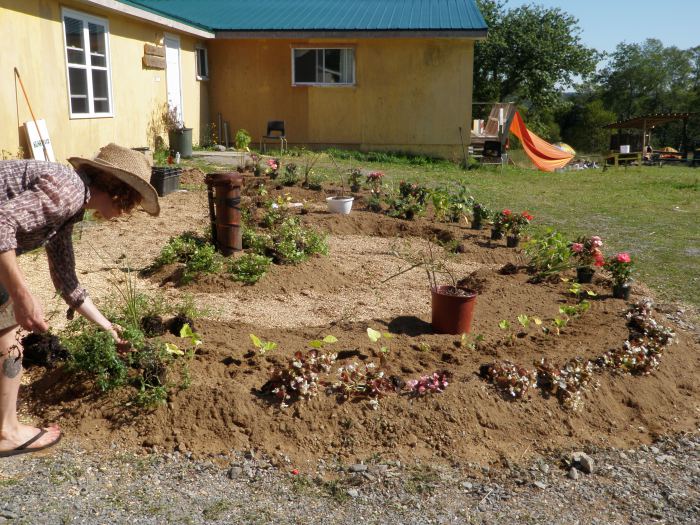Chris Magwood on Carbon Storage – Natural Building EAST conference
Chris Magwood’s research and clear (simple!) path forward to drastically reduce carbon emissions and sequester carbon is a game changer. Please take a few minutes to read all of Richard Bell’s recent article below, then explore the Endeavour Centre website. read The New Carbon Architecture: Building to Cool the Climate, and let us know at the Deanery Project if you would like to part of our on-going climate action initiatives.
A Straw to Save the World
By Richard Bell
[Note: This article is a summary of a lecture by sustainable builder and author Chris Magwood on September 29, 2019, delivered at the Natural Building EAST conference held at the Deanery Project in Ship Harbour, Nova Scotia. Magwood spoke for about an hour, and videos of the entire presentation are available here.]
Chris Magwood built his first straw bale house in 1997, launching a career that has placed him among the most respected sustainable builders and thinkers internationally. He is author of several books on natural building systems including, Making Better Buildings.
On a planet where stopping global warming can all too often seem like an impossible task, nothing Magwood has done previously is likely to have the impact of the stunning findings from the research he did for his recently completed master’s thesis.
Because what Magwood has laid out is a simple, step-by-step pathway to transform the carbon footprint of traditional small-scale residential and office buildings. Using current building techniques and existing materials, he shows to make new buildings a vast sink for removing carbon from the atmosphere, instead of being a vast source of new carbon emissions.
Magwood’s findings are new: he just finished his Master’s thesis less than three months ago. Magwood presented his findings at the recent Natural Building East conference on September 29, held at the Deanery Project in Ship Harbour, Nova Scotia. He could barely contain his enthusiasm: “It makes me vibrate, it’s so exciting. Especially because it happened gradually. I figured out the house numbers, that was cool, and I figured out this, and then I looked at UN projections for grain production. Every time I tried to scratch my assumptions, and figure out what’s the big problem here, am I going to find out we can only build one-tenth of the buildings this way, so it’s not that, every time I would scratch, every part of it was beautiful.”
[Magwood’s master’s thesis, “Opportunities for carbon dioxide removal and storage in building materials” is available as a PDF on his website. This document contains many of the graphs he refers to during his lecture.]
Magwood said he was excited because putting his findings into practice was “eminently doable. Lots of other industries that are responsible for emissions on this scale face an existential threat: you’ve got to stop what you’re doing. In the building sector, we don’t have to stop building, we just have to build better, and we can be part of a solution by continuing to build in a really smart way. This is a message you can take to the industry: we’re not asking you to stop, we’re asking you to join in, be a hero for the climate, and keep doing your business, just do it smarter, think about this stuff before you put it in.”
“We’re looking at a series of learning steps for builders and developers—the path is clear. We’re not asking people to make a massive leap. The leap has steps, and every step is a practical one to achieve.”
Finding the Key: Embodied Carbon
Magwood started this quest when he found a free online database prepared by researchers at the University of Bath. He had been looking for a reliable source of information on how much energy it took to manufacture a given building material, the embodied energy (EE) of that material.
According to UN numbers, buildings are responsible for a big chunk of global carbon emissions. Between the embodied energy in the materials, and the emissions from operating existing buildings, the building sector is responsible for almost 40% of global carbon emissions.
Magwood noticed that the Bath database also had a column on embodied carbon (EC), the amount of carbon that was released into the atmosphere in the manufacture of a given material. He hadn’t thought about embodied carbon before, and decided to include EC with EE in an estimate for the materials to build a small, 1,000 sq. ft. home. He was surprised to find that just the mineral wool insulation alone added 1 Ton of carbon to the atmosphere.
He ran through all the traditional building materials in the database, and discovered that only cellulose, derived from plants, produced negative embodied carbon; that is, because plants remove carbon from the atmosphere in order to grow, using a plant-based material like cellulose actually draws down carbon out of the atmosphere, sequestering it for the life of the building.
Magwood knew that investors were pouring billions of dollars into the search for high-tech machines for removing carbon. But his findings showed we were ignoring a simple truth: “Plants are the machines that do that work,” Magwood said. “We’re surrounded by carbon-capturing machines, really effective ones, and they do it at a rate and a scale we can’t reproduce.”
Confirming the Numbers
Magwood was excited by the numbers he was crunching, but was concerned he didn’t understand what he was doing well enough. He went back to school for a Master’s degree three years ago, which he completed less than 3 months ago.
As he dug into his Masters research, Magwood said he continued to get what he called “crazy answers…A single small building could be responsible for adding hundreds of tons of carbon.” But using natural materials for the same building design was “producing big negative numbers” for removing carbon.
In his thesis, he looked at 400 different building materials, modeling two buildings, a 2,000 sq. ft. bungalow, and a 10,000 sq. ft. 4-story apartment. He found that the data broke down in to four categories:
- Buildings that were very high in embodied carbon
- Buildings with materials in common use,
- Buildings using the best (lowest EC) materials you could buy at Home Depot
- Buildings using the best possible practices and lowest EC materials, similar to what he was doing in his own building practices.
Magwood found that the choice of building materials made a whopping difference in whether a given building was a net carbon emitter or a net carbon drawdown, from over 200 tons of embodied carbon in the worst case to a net drawdown of over 130 tons using the best materials.
What did these numbers amount to across a whole country? Magwood was forced to use numbers from the U.S. because the Canadian government does not track building statistics as a result of Conservative cutbacks.
If all residential building in the U.S. happened at the worst-case level, the resulting embedded carbon emissions would be 54 million tons, the equivalent of the output of 15 large coal plants. On the other hand, if these same buildings were built using the best materials, the result would be the drawdown of 36 million tons of EC, the equivalent of taking 10 large coal plants offline. The net effect of using the best materials would therefore be the equivalent of removing 25 large coal plants (15+10). By way of comparison, “In Ontario, we shut down 6 coal plants, and it was the biggest reduction in emissions ever in North America.”
Adding in Operational Carbon Emissions
Before he started shouting about his findings, Magwood wanted to see how adding in the amount of carbon that would be emitted from operating these buildings (heating, cooling, hot water, etc.) would affect his results. So he took the same two model buildings, and figured out what each configuration would emit over time, combining each building’s EC and operational carbon (OC).
In the case of the larger building, heating with natural gas, and looking out to 2050, he found that the building’s combined EC and OC would amount to adding 500 tons of emissions, about half from materials, and half from operations.
But using the best-case materials and heating with an air source heat pump using the carbon intensity of the Ontario electrical grid produced radically different results. “By 2050, the building’s still a site of large-scale carbon storage. There’s net carbon storage for 150 years.”
High Energy Efficiency Paradox
Magwood also found a surprise when he looked at the impact of using high EC materials in an effort to reduce the operational energy use of a given building. “When I looked at energy efficiency, if the insulation has a high carbon footprint like foam, you drive up the EC of the building. So we’re trying to drive carbon down, but with foam, you get a big jump in the carbon footprint. The opposite happens when you’re using plant-based materials. So using more plant-based materials is good, as opposed to bad.”
In fact, instead of using lots of foam to get high-energy efficiency in operations, Magwood found you would get less carbon-intensive results by just building to code using standard materials, the best of the worst at Home Depot.
“This result is devastating for people who’ve been making energy efficiency the primary goal. People are shouting at me at passive house conferences, ‘No, no, no!’”
The Importance of Air Tightness
Another surprise was the dramatic impact of improving air tightness by simply being careful in installing vapor barriers and wraps through careful building practices produced a dramatic jump in the building’s OC. “You don’t need triple pane windows, or more insulation, you just need more careful building practice with the materials,” Magwood said.
Can We Get the Drawdown Materials We Need?
Magwood said that we are already producing vast quantities of the plant-based materials we need to make the switch to carbon-negative buildings. “We don’t have to start new processes, or cut down more forests, we can use the byproducts of something we already do.”
In 2017, for example, farmers produced an estimated 2 billion tons of grain straw (from wheat, barley, oats, rice, flax, etc.) “Just those plants have taken more C02 out of the atmosphere than all transportation emissions on the planet. Right now, we just burn these stalks, or let them molder and release their carbon back into the atmosphere. Or we could replace all the thermal insulation we use on the planet with this straw, and still leave farmers with the 15-20% they need to turn back into their fields.”
New materials in research & development
Magwood said that in addition to using the vast quantities of plant-based materials that we now throw away, there was also exciting R&D on developing mineral-based building materials that drew down carbon. He highlighted a North Carolina company, Biomason: “They’re growing bricks with microbes. They put sand in a brick mold, put microbes in the sand, and feed the microbes. The microbes shit calcium carbonate that sticks the sand together, and out comes a brick with all the properties of concrete made with no heat.”
He also mentioned the use of biochar, a historically ancient technique for burning materials in the absence of oxygen. “The carbon doesn’t burn, and you get biochar that you can use as a great soil amendment, or put in plasters, insulation, concrete, etc.”
The Role of Big Corporations
Magwood said he was “slightly agnostic” as to whether big corporations got involved in producing natural building materials. “This is not a space I’ve been in very long, but I have now been in rooms with the head of Owens Corning and people like that. They get this, they get the business model. It may very well be that they are the ones who do this. If they are, I would rather somebody do it than nobody do it. If they’re going to do it, at least they’ll be paying farmers for their raw materials rather than oil companies for their raw materials. I don’t think the co-benefits will be as great, but it could happen faster, so I’m kind of slightly agnostic on who does it.
“I would obviously rather it’s a whole bunch of local independent coops doing it locally and regionally. But (the corporate) business model may dictate that they do it more regionally as well. Straw is bulky; it makes less sense to ship it, and you can’t put it in a pipeline. It may make more practical sense for them to have 12 factories across Canada rather than one as they currently do. Maybe some of that stuff happens not because they’re excited about that but because it’s more practical.
“I certainly wouldn’t turn down access to these materials from a company like that, if they’re going to make that difference. I would turn it down if it’s a weird straw foam hybrid that has all kinds of things attached to it. If Dow can figure out how to make an awesome bale bundle that builders want to use, and Home Depot wants to carry, I would take that.”
Hitting a Net Balance
Magwood showed slides of several buildings that store carbon, including one that looked like a little metal box. Getting to a building that provides net carbon storage does not mean that everything has to be made from plant-based materials. There can still be glass windows, or metal roofs, as long as the total adds up to net carbon storage.








